The following article originally appeared on the now-defunct GridFe website but never found its way to Football Perspective after Adam Steele and I decided to shut things down in our little corner of the internet. For the sake of having a reference, I have decided to republish in Chase’s space. Below is the article as originally published following the 2018 season.
Last year, I unveiled the GridFe Hall of Fame, a group effort of football diehards dissatisfied with (and unencumbered by the logistical limitations of) the Pro Football Hall of Fame. [1]The GrideFe Hall of Fame Committee comprises research guru Topher Doll, standard human Bryan Frye, actual genius Adam Harstad, enigmatic fount of knowledge Raider Joe, potentate of … Continue reading This Hall of Fame has very few rules outside of a minimum five “yea” votes out of a possible six for enshrinement. We have no waiting period for induction. If it’s obvious that Tom Brady belongs, he’s in; if we need to take some time to put Julio Jones‘s stats into perspective, we will. We don’t have contribution silos. I didn’t vote for John Madden solely as a coach but as a coach, influential broadcaster, and video game pioneer.
This year, as before, voting consisted of three rounds. In round one, we each named the players we believed to be slam dunks. If anyone appeared on at least five lists, he was in. In round two, we voted on all players, giving us the opportunity to give further consideration to players we did not name on our own lists. Again, anyone with at least five votes made it through. In the final round, we presented cases for those in whom we strongly believed, and we voted after arguments were given. Anyone with five votes made the cut. When the dust settled, we welcomed eight new defenders to the GridFe Hall of Fame. [2]Others receiving votes: Andy Robustelli, John Randle*, Arnie Weinmeister*, Art Donovan, Henry Jordan, Brian Urlacher, Zach Thomas, Mel Renfro*, George Allen
GridFe Hall of Fame Defense
Doug Atkins (1953-1969)
Chicago Bears, New Orleans Saints, Cleveland Browns
8 First Team All Pros; 2 Second Team All Pros; 8 Pro Bowls; 2 Title Wins; 2 Title Losses; 2 GridFe Deacon Awards
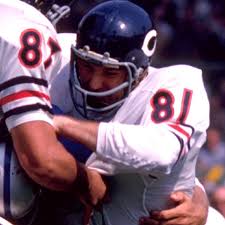 Standing 6’8″ and weighing as much as 275 pounds, Atkins was an imposing figure who dwarfed 1950s offensive linemen. He possessed the power you’d expect from such a behemoth, often using brute force to dominate the line of scrimmage. One of his signature moves was tossing tackles to the side with an arm swipe reminiscent of a bear batting a salmon out of the air. Legend has it that offensive linemen were afraid to hold him because they didn’t want to incur his subsequent wrath. Unfortunately for offenses, Atkins wasn’t just a big man; he was also a terrific athlete with rare quickness and an impressive vertical leap. [3]At his size, he won the Southeastern Conference high jump title as a collegian. He also used his combination of height and jumping skill to be one of the better kick blockers in history. His most famous pass rush move involved him leaping right over offensive linemen who tried to cut block him. His ability to win with power or athleticism proved to be a nightmare for quarterbacks—historian Nick Webster estimates that Atkins could have notched more than 150 sacks in his career.
Standing 6’8″ and weighing as much as 275 pounds, Atkins was an imposing figure who dwarfed 1950s offensive linemen. He possessed the power you’d expect from such a behemoth, often using brute force to dominate the line of scrimmage. One of his signature moves was tossing tackles to the side with an arm swipe reminiscent of a bear batting a salmon out of the air. Legend has it that offensive linemen were afraid to hold him because they didn’t want to incur his subsequent wrath. Unfortunately for offenses, Atkins wasn’t just a big man; he was also a terrific athlete with rare quickness and an impressive vertical leap. [3]At his size, he won the Southeastern Conference high jump title as a collegian. He also used his combination of height and jumping skill to be one of the better kick blockers in history. His most famous pass rush move involved him leaping right over offensive linemen who tried to cut block him. His ability to win with power or athleticism proved to be a nightmare for quarterbacks—historian Nick Webster estimates that Atkins could have notched more than 150 sacks in his career.
Lee Roy Selmon (1976-1984)
Tampa Bay Buccaneers
5 First Team All Pros, 2 Second Team All Pros, 6 Pro Bowls, 1 GridFe Godzilla Award, 1 GridFe Deacon Award
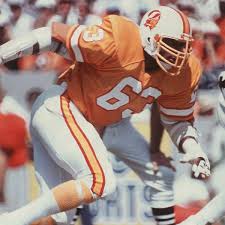 Selmon began his pro career as the first ever pick and lone bright spot for the expansion Tampa Bay Buccaneers. He ultimately became the cornerstone of the franchise as the team moved to respectability. Selmon is undoubtedly on Mount Rushmore of 3-4 ends, was arguably a top three player at the position in eight of his nine pro seasons. [4]The NFLPA named his the NFC’s best defensive lineman four times. That’s half of his healthy seasons. A size-speed freak with exceptional athletic gifts (and intelligence to match), Selmon could play both the pass and the run with aplomb. [5]He was also a superb kick blocker. While many today remember him for his elite run stuffing acumen, Selmon finished his brief career with 79 sacks. That’s an average of nine per year, including a strike-shortened 1982 and a rookie year that saw him miss six games to injury. He did this despite playing in a disadvantageous situation for accruing gaudy sack numbers: for most of his tenure, he was a 3-4 end with two gap responsibility and a generally average linebacking corps behind him. [6]This is after a rookie year that saw him play inside often in Tampa’s failed experiment with the 4-3 defense.
Selmon began his pro career as the first ever pick and lone bright spot for the expansion Tampa Bay Buccaneers. He ultimately became the cornerstone of the franchise as the team moved to respectability. Selmon is undoubtedly on Mount Rushmore of 3-4 ends, was arguably a top three player at the position in eight of his nine pro seasons. [4]The NFLPA named his the NFC’s best defensive lineman four times. That’s half of his healthy seasons. A size-speed freak with exceptional athletic gifts (and intelligence to match), Selmon could play both the pass and the run with aplomb. [5]He was also a superb kick blocker. While many today remember him for his elite run stuffing acumen, Selmon finished his brief career with 79 sacks. That’s an average of nine per year, including a strike-shortened 1982 and a rookie year that saw him miss six games to injury. He did this despite playing in a disadvantageous situation for accruing gaudy sack numbers: for most of his tenure, he was a 3-4 end with two gap responsibility and a generally average linebacking corps behind him. [6]This is after a rookie year that saw him play inside often in Tampa’s failed experiment with the 4-3 defense.
Howie Long (1981-1993)
Oakland/Los Angeles Raiders
4 First Team All Pros, 2 Second Team All Pros, 8 Pro Bowls, 1 Title Win, 1 GridFe Godzilla Award, 2 GridFe Deacon Awards
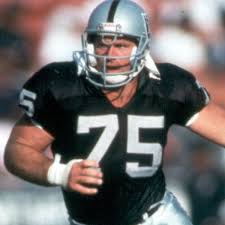 Playing most of his prime as a 3-4 defensive end, Long joins Selmon on the position’s mountaintop. Explosive and stout, vicious and intelligent, excellent against the run and the pass, able to win from the inside or the outside, he had no holes in his game. Long didn’t always receive the acclaim of more heralded pass rushing ends, but the comparison isn’t necessarily apt: rather than rushing from the edge, he generally played inside in passing situations, and he never sacrificed his responsibility against the run in order to chase sacks. Despite committing to his run duties, playing inside often, and absorbing consistent double teams, Long was able to accumulate 91.5 sacks. His pass rushing prowess was on full display in 1983, when he notched five sacks in a single game against the mighty Hogs of Washington.
Playing most of his prime as a 3-4 defensive end, Long joins Selmon on the position’s mountaintop. Explosive and stout, vicious and intelligent, excellent against the run and the pass, able to win from the inside or the outside, he had no holes in his game. Long didn’t always receive the acclaim of more heralded pass rushing ends, but the comparison isn’t necessarily apt: rather than rushing from the edge, he generally played inside in passing situations, and he never sacrificed his responsibility against the run in order to chase sacks. Despite committing to his run duties, playing inside often, and absorbing consistent double teams, Long was able to accumulate 91.5 sacks. His pass rushing prowess was on full display in 1983, when he notched five sacks in a single game against the mighty Hogs of Washington.
Julius Peppers (2002-2018)
Carolina Panthers, Chicago Bears, Green Bay Packers
4 First Team All Pros, 2 Second Team All Pros, 9 Pro Bowls, 1 Title Loss, 1 GridFe Deacon Award
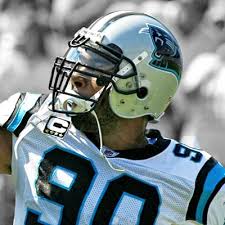 One of the greatest athletes ever to play the position (or any position, for that matter), Peppers immediately made his presence felt on the field. He used his long arms to keep blockers at bay, his power to disengage them with apparent ease, and his speed to chase down backs or passers. Criticized early on for inconsistency, much of that lends itself to the fact that Peppers almost never came off the field, which began to take its toll near the end of each season. Even at his low points, he went from otherworldly to merely good. His pass rushing prowess is well known: he currently ranks fifth all-time in sacks (and is just one away from jumping Kevin Greene) and is one of just three players with a decade’s worth of double digit sacks. [7]He has exactly ten. Bruce Smith had thirteen, and Reggie White had twelve in the NFL and at least one in the USFL. In addition to rushing the passer, Peppers was adept against the rush and possessed a sixth sense for making splash plays: he defensed 86 passes, stole eleven interceptions, forced 52 fumbles, recovered 19 fumbles, and scored two touchdowns. Tall and long with excellent leaping ability, he was great kick blocker and probably could have been a star tight end had he chosen that position instead.
One of the greatest athletes ever to play the position (or any position, for that matter), Peppers immediately made his presence felt on the field. He used his long arms to keep blockers at bay, his power to disengage them with apparent ease, and his speed to chase down backs or passers. Criticized early on for inconsistency, much of that lends itself to the fact that Peppers almost never came off the field, which began to take its toll near the end of each season. Even at his low points, he went from otherworldly to merely good. His pass rushing prowess is well known: he currently ranks fifth all-time in sacks (and is just one away from jumping Kevin Greene) and is one of just three players with a decade’s worth of double digit sacks. [7]He has exactly ten. Bruce Smith had thirteen, and Reggie White had twelve in the NFL and at least one in the USFL. In addition to rushing the passer, Peppers was adept against the rush and possessed a sixth sense for making splash plays: he defensed 86 passes, stole eleven interceptions, forced 52 fumbles, recovered 19 fumbles, and scored two touchdowns. Tall and long with excellent leaping ability, he was great kick blocker and probably could have been a star tight end had he chosen that position instead.
Aaron Donald (2014-present)
St. Louis/Los Angeles Rams
5 First Team All Pros, 5 Pro Bowls, 1 Title Loss, 2 GridFe World Awards, 1 GridFe Godzilla Award, 4 GridFe Mean Awards
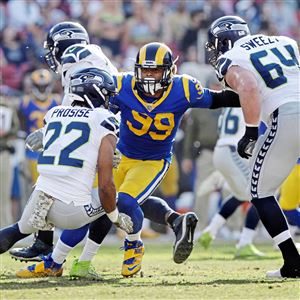 It may seem too early to name Donald to the GridFe Hall of Fame. He has played five seasons and 78 regular season games in his career. But consider this: as an interior pass rusher, he has averaged twelve sacks per season (including breaking the single season record for defensive tackles), he’s one of eight players to win multiple defensive player of the year honors from the Associated Press, [8]Others include Joe Greene (the only other DT), Mike Singletary, Lawrence Taylor (3), Reggie White, Bruce Smith, Ray Lewis, and J.J. Watt (3). They are all inaugural members of the GridFe Hall of Fame., he has earned a Pro Bowl selection and first team all pro nod every season of his brief career, and his 78 games are as many as fourteen players already in the Pro Football Hall of Fame. [9]Joe Guyon (46), Fritz Pollard (49), Jim Thorpe (52), Ernie Nevers (54), Cliff Battles (60), Doak Walker (67), Ace Parker and Gale Sayers (68), Arnie Weinmeister (71), Dick Stanfel (73), Dutch Clark … Continue reading Most legendary defensive tackles take their places in history based on a handful of great years surrounded by some good years. Donald has already produced as many dominant seasons as any non-Rushmore defensive tackle, and his peak play is arguably greater than that of anyone ever to play the position. He doesn’t need to hang around for a few more years to cement his place in the Pantheon of defenders; he’s already there. In addition to challenging Alan Page as the top pass rushing defensive tackle in history, Donald is also among the best run-defending defensive linemen of his era, stuffing runners at or behind the line of scrimmage at an unprecedented rate. Regardless of what he is called to do, he can do it better than nearly anyone. On the short side, but with an incredibly muscular build, Donald can out-leverage any lineman one on one and routinely beats double teams. He possesses the quickness of an edge rusher and has an arsenal of hand moves that consistently frustrates centers and guards. Perhaps his greatest gift is his ability to sense how a play is going to develop and how offensive lines are going to block him, enabling him to act rather than react to opponents.
It may seem too early to name Donald to the GridFe Hall of Fame. He has played five seasons and 78 regular season games in his career. But consider this: as an interior pass rusher, he has averaged twelve sacks per season (including breaking the single season record for defensive tackles), he’s one of eight players to win multiple defensive player of the year honors from the Associated Press, [8]Others include Joe Greene (the only other DT), Mike Singletary, Lawrence Taylor (3), Reggie White, Bruce Smith, Ray Lewis, and J.J. Watt (3). They are all inaugural members of the GridFe Hall of Fame., he has earned a Pro Bowl selection and first team all pro nod every season of his brief career, and his 78 games are as many as fourteen players already in the Pro Football Hall of Fame. [9]Joe Guyon (46), Fritz Pollard (49), Jim Thorpe (52), Ernie Nevers (54), Cliff Battles (60), Doak Walker (67), Ace Parker and Gale Sayers (68), Arnie Weinmeister (71), Dick Stanfel (73), Dutch Clark … Continue reading Most legendary defensive tackles take their places in history based on a handful of great years surrounded by some good years. Donald has already produced as many dominant seasons as any non-Rushmore defensive tackle, and his peak play is arguably greater than that of anyone ever to play the position. He doesn’t need to hang around for a few more years to cement his place in the Pantheon of defenders; he’s already there. In addition to challenging Alan Page as the top pass rushing defensive tackle in history, Donald is also among the best run-defending defensive linemen of his era, stuffing runners at or behind the line of scrimmage at an unprecedented rate. Regardless of what he is called to do, he can do it better than nearly anyone. On the short side, but with an incredibly muscular build, Donald can out-leverage any lineman one on one and routinely beats double teams. He possesses the quickness of an edge rusher and has an arsenal of hand moves that consistently frustrates centers and guards. Perhaps his greatest gift is his ability to sense how a play is going to develop and how offensive lines are going to block him, enabling him to act rather than react to opponents.
Willie Lanier (1967-1977)
Kansas City Chiefs
8 First Team All Pros (2 AFL/6 NFL), 8 Pro Bowls (2 AFL/6 NFL), 1 Title Win, 4 GridFe Enforcer Awards (2 AFL/2 NFL)
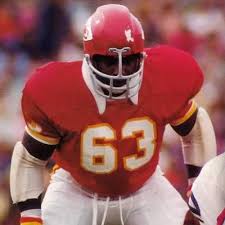 Known as Contact for his punishing tackling style that jarred ball carriers, Lanier was also a sure tackler whom Dr. Z once referred to as a run stuffer supreme (remember, he played in an era when stuffing runs still mattered). As good as he was against the run, he was arguably even better in coverage. Interceptions are rarely a great stat to point to as proof of such ability, but Lanier’s 27 career picks are a tangible evidence of his work as a cover man. Film shows a player with great quickness and instincts, able to operate well in space and anticipate where the quarterback wanted to throw. Lanier came into the league facing similar racial prejudices that kept African Americans from landing roles as starting quarterbacks. [10]It was a widespread belief at the time that white players were the only ones capable of handling the mental burden of playing quarterback, middle linebacker, and center. Even after other positions … Continue reading Fortunately, the AFL realized what he could do on the field and gave him the opportunity to prove traditionalists wrong. He didn’t take long, earning postseason honors his second year as a pro and every year after till he turned 30. [11]This isn’t just one of those media creations, where a player is recognized for his uniqueness rather than his greatness; the NFL Players Association named him the AFC’s best linebacker … Continue reading Lanier was a trailblazer whose performance on a championship defense paved the way for future generations of black players to patrol the middle of the defense.
Known as Contact for his punishing tackling style that jarred ball carriers, Lanier was also a sure tackler whom Dr. Z once referred to as a run stuffer supreme (remember, he played in an era when stuffing runs still mattered). As good as he was against the run, he was arguably even better in coverage. Interceptions are rarely a great stat to point to as proof of such ability, but Lanier’s 27 career picks are a tangible evidence of his work as a cover man. Film shows a player with great quickness and instincts, able to operate well in space and anticipate where the quarterback wanted to throw. Lanier came into the league facing similar racial prejudices that kept African Americans from landing roles as starting quarterbacks. [10]It was a widespread belief at the time that white players were the only ones capable of handling the mental burden of playing quarterback, middle linebacker, and center. Even after other positions … Continue reading Fortunately, the AFL realized what he could do on the field and gave him the opportunity to prove traditionalists wrong. He didn’t take long, earning postseason honors his second year as a pro and every year after till he turned 30. [11]This isn’t just one of those media creations, where a player is recognized for his uniqueness rather than his greatness; the NFL Players Association named him the AFC’s best linebacker … Continue reading Lanier was a trailblazer whose performance on a championship defense paved the way for future generations of black players to patrol the middle of the defense.
Randy Gradishar (1974-1983)
Denver Broncos
6 First Team All Pros, 2 Second Team All Pros, 7 Pro Bowls, 1 Title Loss, 2 GridFe Enforcer Awards
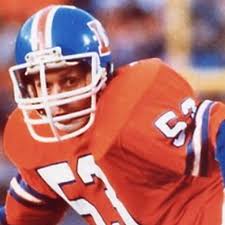 Readers should not lose sight of the fact that the GridFe Hall of Fame was created because the decisions of the traditional Hall of Fame did not perfectly align with the values of a handful of disgruntled fans. “Enshrine Randy Gradishar” was practically this deliberative body’s mission statement. Gradishar’s traditional supporters point to his tackle stats—he reportedly retired with the career record and averaged a cartoonish 226 tackles per 16 games. Gradishar’s traditional detractors scream that those stats are inflated. [12]They certainly are, though probably not as much as the detractors would have you believe. By making Gradishar’s case about tackles, his candidacy has turned into a proxy war for the reliability of Denver’s home-town stat-keepers rather than a referendum on Gradishar himself. Since the only winning move is not to play, we will not discuss his tackle stats any further.
Readers should not lose sight of the fact that the GridFe Hall of Fame was created because the decisions of the traditional Hall of Fame did not perfectly align with the values of a handful of disgruntled fans. “Enshrine Randy Gradishar” was practically this deliberative body’s mission statement. Gradishar’s traditional supporters point to his tackle stats—he reportedly retired with the career record and averaged a cartoonish 226 tackles per 16 games. Gradishar’s traditional detractors scream that those stats are inflated. [12]They certainly are, though probably not as much as the detractors would have you believe. By making Gradishar’s case about tackles, his candidacy has turned into a proxy war for the reliability of Denver’s home-town stat-keepers rather than a referendum on Gradishar himself. Since the only winning move is not to play, we will not discuss his tackle stats any further.
Gradishar was one of the best linebackers in college history. He was drafted by a team with no history of success and played ten years without missing a game. He was universally hailed as the best player on a famous defense littered with stars, and when he retired his nine seasons as a starter included the seven best defenses in Denver history [13]And eight of the top ten. as measured by SRS. He made seven pro bowls, was named first-team All Pro by a major publication in six different seasons, and was the 1978 AP Defensive Player of the Year. Famous for his instincts, as sure of a tackler as the league has ever seen, devastating in short yardage, but also among history’s most skilled at dropping back into coverage, Gradishar was an all-around star. He possessed incredible range before incredible range was a flashy thing for a linebacker to possess. [14]Joel Buchsbaum of Pro Football Weekly wrote “there are quite a few scouts who will tell you that former Broncos ILB Randy Gradishar was almost as good, even as good, as Jack Lambert.” He didn’t have a reputation for ferocious hits, but when Walter Payton was asked about the hardest hit of his NFL career, he responded with “Randy Gradishar, 1978.”
Von Miller (2011-present)
Denver Broncos
7 First Team All Pros, 7 Pro Bowls, 1 Title Win, 1 GridFe Godzilla Award, 5 GridFe Dobre Shunka Awards
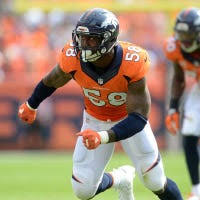 Perhaps it feels premature to place Miller alongside the pass-rushing legends of yore at this juncture. We must confess that there were those among us who initially felt the same about a man who has not yet played a snap of football after his thirtieth birthday. But upon examination Miller’s body of work already holds up against even the all-time greats. He has played ten games or more just seven times but already has as many seasons with double-digit sacks as Lawrence Taylor or Derrick Thomas. [15]7 apiece. Among players who were primarily considered linebackers through their career, only former teammate DeMarcus Ware (8) has more. [16]Though it should be noted that positional designations for edge rushers are often fluid.
Perhaps it feels premature to place Miller alongside the pass-rushing legends of yore at this juncture. We must confess that there were those among us who initially felt the same about a man who has not yet played a snap of football after his thirtieth birthday. But upon examination Miller’s body of work already holds up against even the all-time greats. He has played ten games or more just seven times but already has as many seasons with double-digit sacks as Lawrence Taylor or Derrick Thomas. [15]7 apiece. Among players who were primarily considered linebackers through their career, only former teammate DeMarcus Ware (8) has more. [16]Though it should be noted that positional designations for edge rushers are often fluid.
Officially, only Ware and Jared Allen had more career sacks before their thirtieth birthday. [17]Lawrence Taylor also passes him by half a sack if we for a minute stop pretending that pass-rushing was invented in 1982. Also, with an unofficial 106 sacks through 1968, Deacon Jones sits atop the … Continue reading Miller has made the pro bowl and been named a 1st-team All Pro by at least one major publication for every healthy year of his career and was named Super Bowl MVP after he (and Ware) dominated the 2015 postseason. [18]Just the ninth time a defender has been so honored. Seemingly the most naturally gifted pass-rusher the league has ever seen, many players are known for one or two dominant moves but in Miller’s arsenal are a genuinely unprecedented number of top-level moves, countermoves, and counter-countermoves, supplemented by one of the quickest first steps in league history. While many of his fellow pocket-disruptors treat the running game as someone else’s concern, Miller draws praise for his run support and even for his ability to hold up in coverage on the rare occasions the Broncos have asked him to drop away from the line of scrimmage.
References
| ↑1 | The GrideFe Hall of Fame Committee comprises research guru Topher Doll, standard human Bryan Frye, actual genius Adam Harstad, enigmatic fount of knowledge Raider Joe, potentate of prognostication Thomas McDermott, and quarterback aficionado Adam Steele. |
|---|---|
| ↑2 | Others receiving votes: Andy Robustelli, John Randle*, Arnie Weinmeister*, Art Donovan, Henry Jordan, Brian Urlacher, Zach Thomas, Mel Renfro*, George Allen |
| ↑3 | At his size, he won the Southeastern Conference high jump title as a collegian. He also used his combination of height and jumping skill to be one of the better kick blockers in history. |
| ↑4 | The NFLPA named his the NFC’s best defensive lineman four times. That’s half of his healthy seasons. |
| ↑5 | He was also a superb kick blocker. |
| ↑6 | This is after a rookie year that saw him play inside often in Tampa’s failed experiment with the 4-3 defense. |
| ↑7 | He has exactly ten. Bruce Smith had thirteen, and Reggie White had twelve in the NFL and at least one in the USFL. |
| ↑8 | Others include Joe Greene (the only other DT), Mike Singletary, Lawrence Taylor (3), Reggie White, Bruce Smith, Ray Lewis, and J.J. Watt (3). They are all inaugural members of the GridFe Hall of Fame. |
| ↑9 | Joe Guyon (46), Fritz Pollard (49), Jim Thorpe (52), Ernie Nevers (54), Cliff Battles (60), Doak Walker (67), Ace Parker and Gale Sayers (68), Arnie Weinmeister (71), Dick Stanfel (73), Dutch Clark and George McAfee (75), Wayne Millner (76), and Terrell Davis (78). A full season next year will see him catch an additional fifteen players. |
| ↑10 | It was a widespread belief at the time that white players were the only ones capable of handling the mental burden of playing quarterback, middle linebacker, and center. Even after other positions were integrated, those positions belonged to the good ol’ boys club. |
| ↑11 | This isn’t just one of those media creations, where a player is recognized for his uniqueness rather than his greatness; the NFL Players Association named him the AFC’s best linebacker every year from 1970-74. |
| ↑12 | They certainly are, though probably not as much as the detractors would have you believe. |
| ↑13 | And eight of the top ten. |
| ↑14 | Joel Buchsbaum of Pro Football Weekly wrote “there are quite a few scouts who will tell you that former Broncos ILB Randy Gradishar was almost as good, even as good, as Jack Lambert.” |
| ↑15 | 7 apiece. |
| ↑16 | Though it should be noted that positional designations for edge rushers are often fluid. |
| ↑17 | Lawrence Taylor also passes him by half a sack if we for a minute stop pretending that pass-rushing was invented in 1982. Also, with an unofficial 106 sacks through 1968, Deacon Jones sits atop the list. Of course, Reggie White had 118.5 sacks before turning 30 if you include the 23.5 he recorded in the USFL. |
| ↑18 | Just the ninth time a defender has been so honored. |
